
To provide a sense for aircraft flight patterns in the vicinity of the airport Dane County Regional Airport, plots below show sampled individual flight tracks for a variety of aircraft types and operations. Flight tracks for all but military fighter jets are from data gathered by the MSNSound ADS-B receiver. Fighter jets mostly do not transmit this data, but noise metering provides a good gauge for flight incidence and direction. Details about fighter jet operations and flight paths is provided at the bottom of the page.
The airport has three runways, which—as with all airports—are numbered at each end according to the compass heading of the runway (rounded to the nearest 10 degrees):

Almost all commercial airliners and military fighters use Runway 18/36, which accounts for about 70 percent of all aircraft operations in and out of the airport. The other two runways are mainly used by smaller business jets and small general-aviation aircraft.
Large jets are here defined as turbofan aircraft with a maximum gross take-off weight of 20,000 pounds or more. This includes the larger commercial airline aircraft that operate in and out of the DCRA, such as the Boeing 737, Airbus A319, Embraer ERJ-170 and Bombardier CL-600. A few larger business jets are also included in this category, as well as the occasional visiting military transport aircraft, such as the Boeing C-17A. Large jets account for about a third of the aircraft operations in the vicinity of the airport.
Most large jets depart using the main north-south runway (Runway 18/36), then head towards fixed navigational waypoints in the general direction of their destination shortly after departure. Departing airliners generally climb quickly to 4,000 feet above the airport elevation shortly after departure: this tends to mitigate the noise impacts beyond about 5 miles from the airport.

In contrast to the dispersed nature of departing large jets, large-jet arrivals are highly concentrated along tracks that align with the airport runways. This is because commercial airliners practice stabilized-approach procedures that call for lining up with the intended runway 5 miles or more away from the airport to avoid last-minute maneuvering during landing.
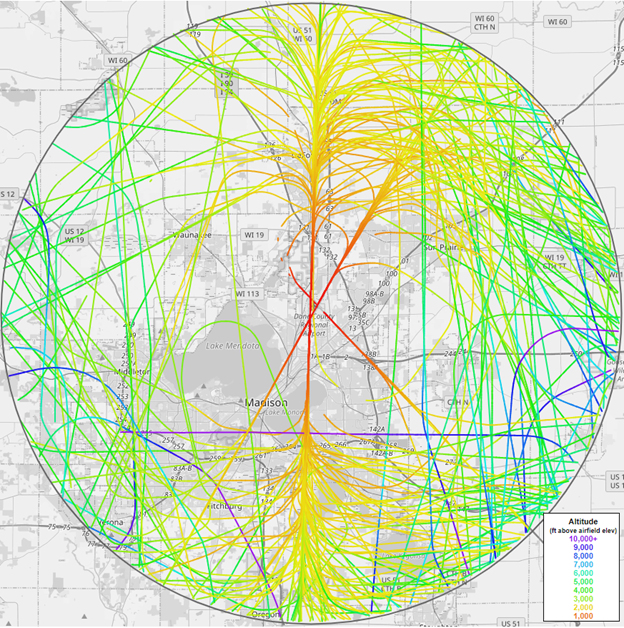
Small jets (i.e., turbofan-powered aircraft with a maximum gross take-off weight of less than 20,000 lbs.) include general-aviation business jets such as various Learjet and Cessna Citation models as well as smaller commercial aircraft such as the Embraer ERJ-145. Small jets account for about 8 percent of aircraft non-fighter operations in and out of the airport. These aircraft are more likely to utilize the airport’s smaller two runways for departures and arrivals.
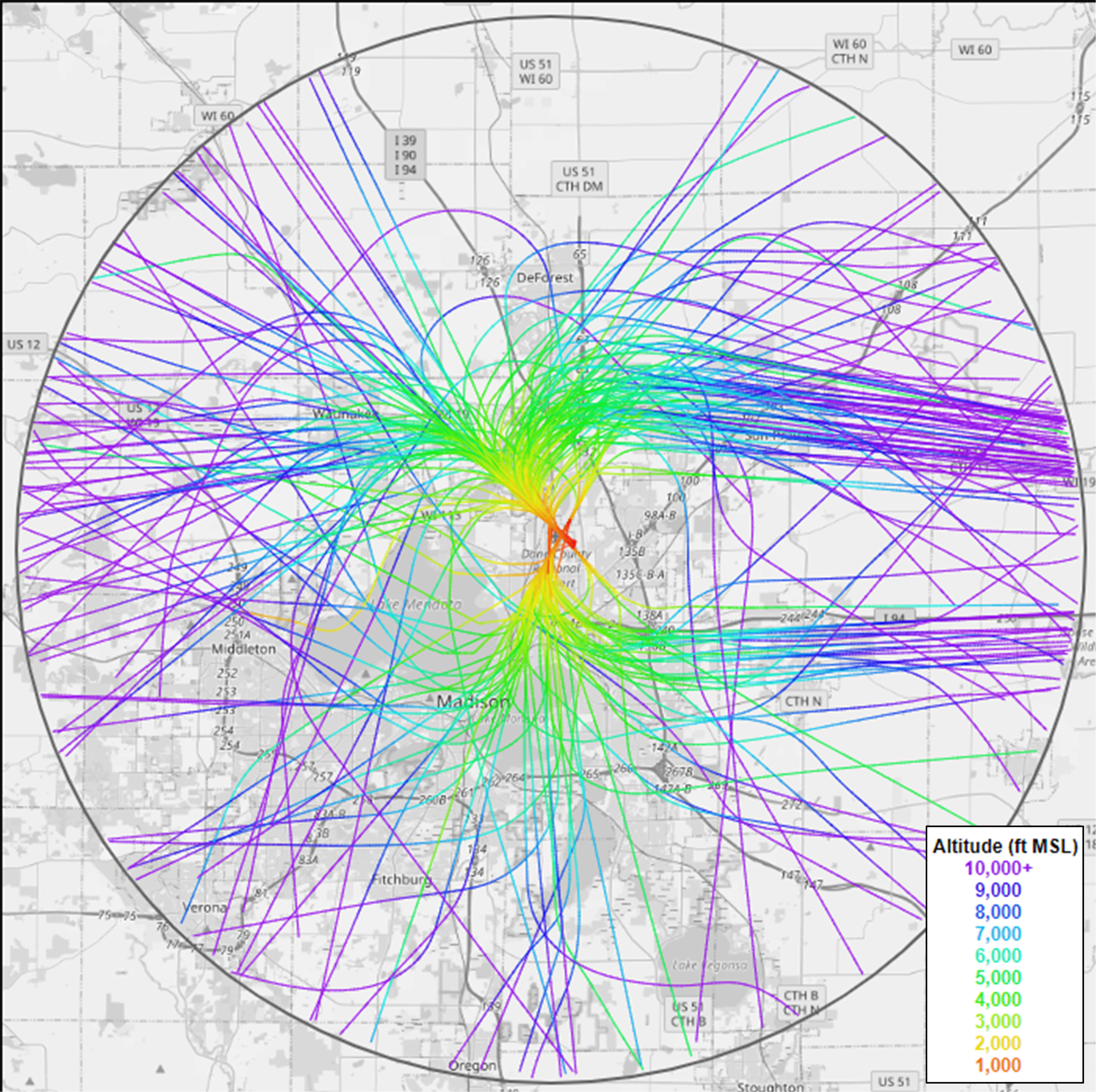

Large prop aircraft are defined here as propellor-driven aircraft with a maximum gross take-off weight of at least 12,500 pounds or having seating for 15 or more people. The most common aircraft in this category at the DCRA are the Pilatus PC-12, Shorts 360 and the Beech Super King Air, with the latter including its military equivalent, the Beech C-12 Huron. Lockheed Martin KC-130 military refueling tankers also occasionally operate in and out of the DCRA as well. Large prop aircraft make up only about 4 percent of airport aircraft operations.
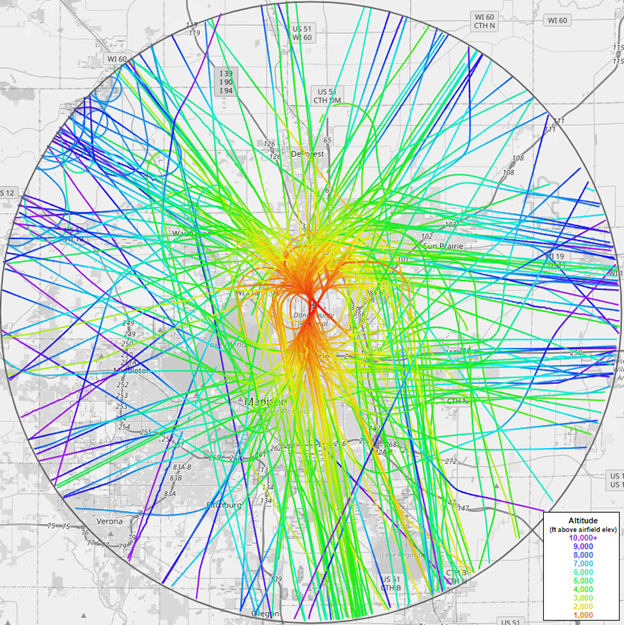
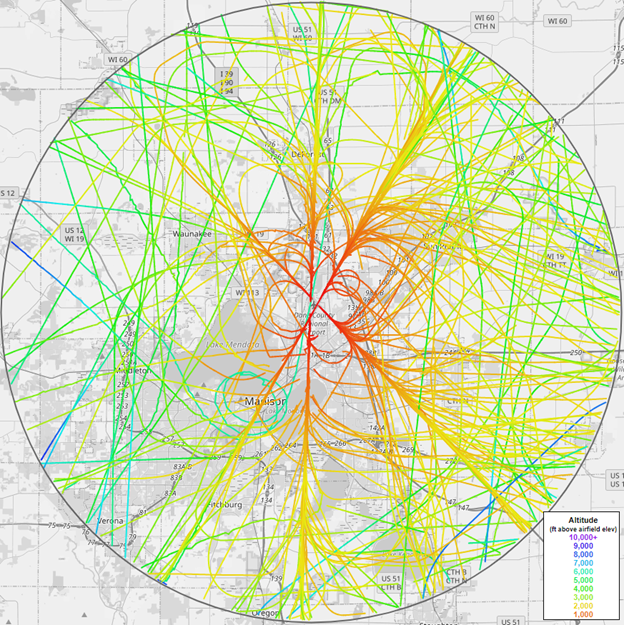
Small propellor-driven aircraft are those with a maximum gross take-off weight of less than 12,500 pounds and fewer than 15 seats. By count, this category comprises the greatest number of aircraft operating in the Madison area, comprising all manner of light single- and twin-engine general aviation aircraft such as the familiar Cessna 172, Piper Cherokee and Piper Twin Comanche. Small prop aircraft account for a third of airport operations.
Flight tracks for these aircraft show a fair amount of circuit pattern work and touch-and-go landing practice at the DCRA and nearby Morey Airfield in Middleton.
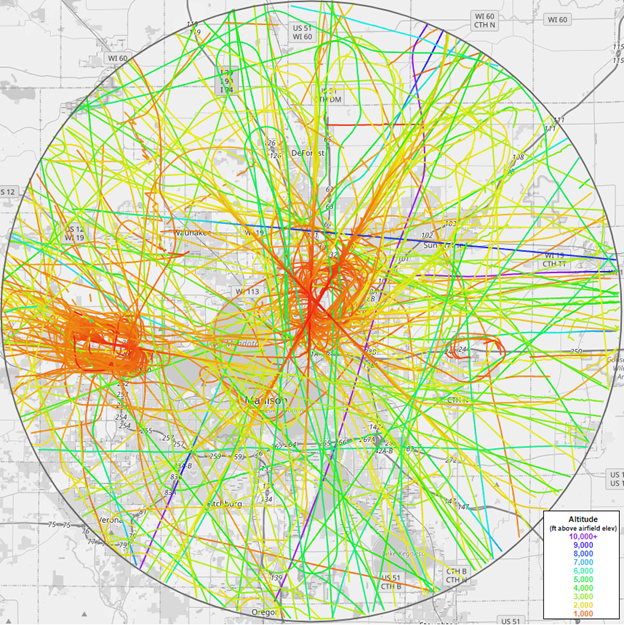
Civilian helicopter traffic in the Madison area mostly consists of Med Flight aircraft operating in and out of UW Hospital or Meriter Hospital. These aircraft often refuel at the DCRA. Civilian helicopters constitute about 5 percent of airport operations.
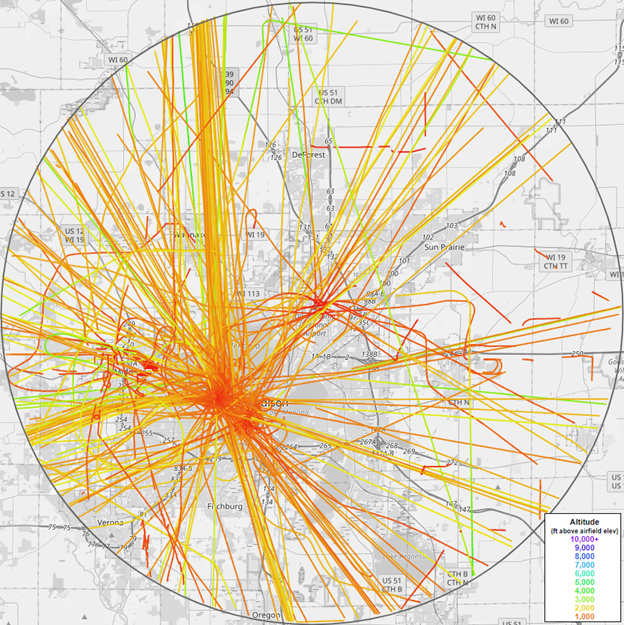
Military helicopter traffic is almost entirely Sikorsky UH-60 Black Hawk aircraft for the Wisconsin Army National Guard (1st Battalion, 147th Aviation Regiment) based at Truax field. These aircraft make up about 2 percent of airport operations.
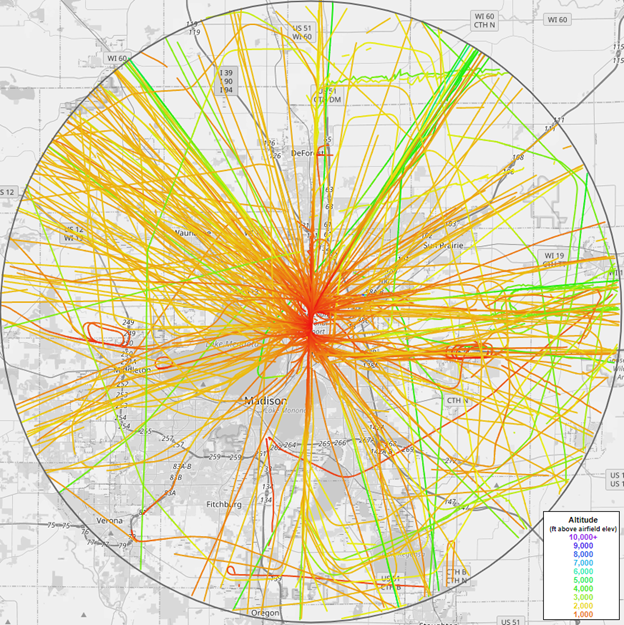
Fighter jets make up about 15 percent of airport aircraft operations, though this number is difficult to accurately establish from MSNSound tracking data given that most fighter jets do not transmit ADS-B data and often depart and arrive in formation pairs. Fighter jets almost exclusively use the main north/south runway (18/36), because it has a cable arresting system for stopping the jets in case of an aborted take-off or an emergency landing. (Rarely, fighters use Runway 03/21, which has a less capable cable-arrest system.) In most cases, fighter jets depart and arrive in formation pairs, sometimes with multiple pairs separated by only a few minutes. The local 115th Fighter Wing typically flies two missions per day during weekdays, with aircraft departing during the mid-morning and early-afternoon hours and returning about 90 minutes later.
Local fighter jets do not transmit the ADS-B data needed for detailed flight tracking like that seen in the plots above, but they do often briefly show up as TIS-B signatures on unfiltered flight-tracking services, such as ADS-B Exchange, and they fly a limited number of flight paths, so typical departure and arrival paths can be approximated.
The airport has a standing NOTAM (Notice to Air Missions) that directs all military aircraft to depart to the north when able. If a south departure is needed, fighter jets are to immediately turn to the southeast at a heading of 140 degrees or less after departure. The departure direction for fighter jets can readily be inferred from the pattern of noise generated across the MSNSound network of meters: the data indicate that 70% of fighter jet departures are to the north and 30% are to the south.
The local 115th Fighter Wing trains in areas to the northwest of Madison, so these jets head in that direction after departure. As a noise mitigation measure, the jets typically climb quickly to about 9,000 feet above the local terrain (10,000 ft MSL). Per the Madison F35 Community Connection FAQ, after-burners are rarely used for F-35 departures from the Madison airport.
The figure below shows TIS-B tracking data for a representative fighter jet departure to the south, starting shortly after departure from Runway 18.
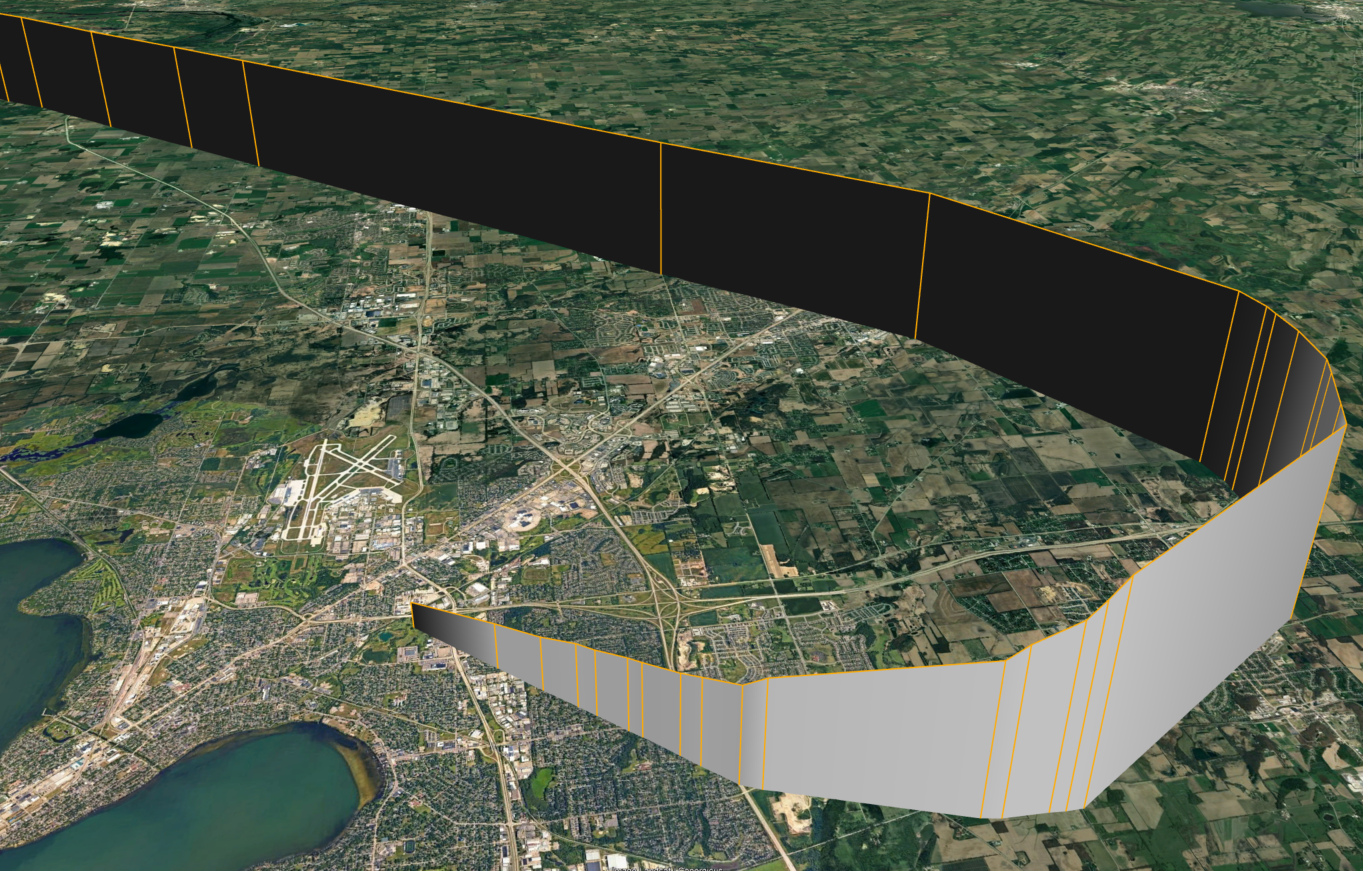
Transient fighter jets from other areas may follow different departure paths—and do not always follow the dictates of the military NOTAM regarding departure headings.
Arriving fighter jets normally execute what is known as an "overhead approach" for landing. This means that they first fly directly over the airport at about 2,500 feet above the ground, then circle and descend to land. The figure below shows the flight path for an overhead approach from the south for a fighter jet, in this case for a transient T-38 fighter jet that transmitted detailed ADS-B position and altitude data (flight paths for the local 115th fighters are similar). For formation arrivals, the trailing aircraft flies a more elongated oval to create needed separation for landing. The standing military NOTAM dictates that overhead approaches break to the west regardless of the arrival direction.
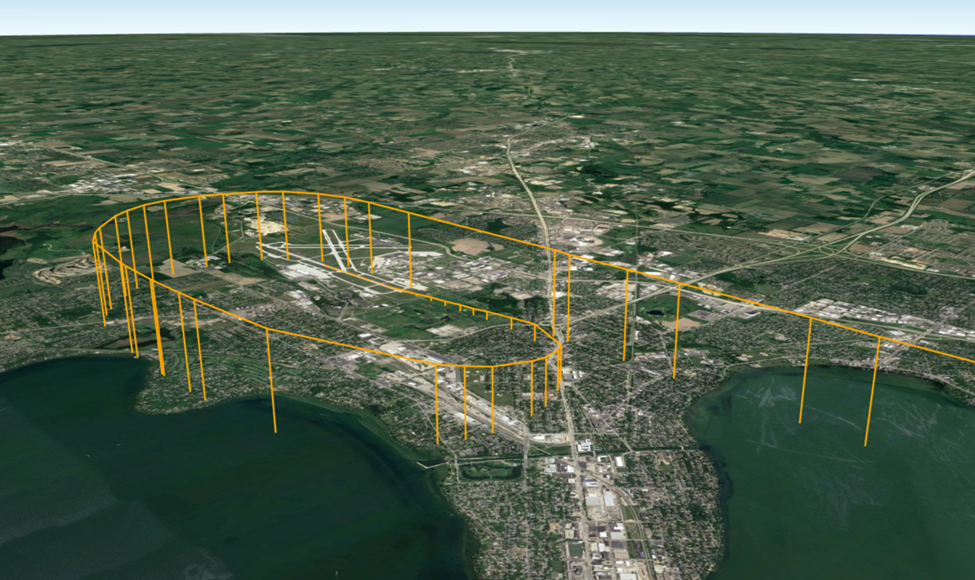
Fighter jets do sometimes execute straight-in approaches similar to commercial airliners, mainly when poor weather does not allow for a visual overhead approach. The shallower approach angle for straight-in arrivals typically requires a high power setting (and thus more noise) than overhead approaches.
Fighter-jet arrivals from the north may not show up on enough meters in the MSNSound network to be easily distinguished from other transient noise sources. This manifests in an imbalance of recorded noise events for fighter jets: about 60 percent of fighter jet noise events are departure events and 40 percent are arrivals.